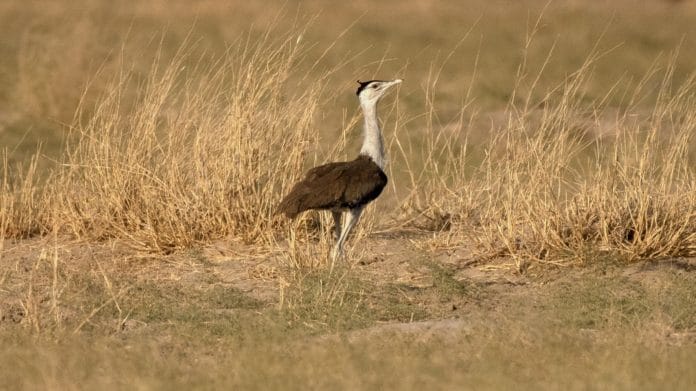New Delhi: The Union ministries of Environment, Renewable Energy, and Power came together earlier this week to submit an application before the Supreme Court, urging it to modify its earlier order of putting high-transmission power lines underground, to protect the habitat of the Great Indian Bustard.
The Supreme Court’s order was in response to a public interest litigation by wildlife activists who argued that the already critically endangered birds — said to number only around 150 in a report submitted to the court — were fatally colliding with power transmission lines.
Great Indian Bustards (GIBs) thrive in arid landscapes like open grasslands, which are also ideal spots for solar and wind plants, leading to a long-standing legal tussle between conservationists and the government.
The government, in its latest application, has said that pushing transmission lines underground will lead to exorbitant costs, which in turn will come in the way of India’s ambitious renewable energy goals. If India’s renewable energy goals aren’t met, the government claims, it could be detrimental to the environment.
“So far, only a minuscule three per cent of the estimated potential of around 263 GW of renewable energy in this area has been tapped. If the remaining potential stays untapped, we will need an additional 93,000 MW of coal-fired capacity to replace the unutilised renewable energy in the future, which would cause an adverse direct impact on the environment,” says the application.
ThePrint explains all you need to know about the Great Indian Bustard and the arguments made by conservationists.
Also read: India’s green energy goals have a serious problem – the Great Indian Bustard
Conserving the GIB
In 1969, there were reportedly 1,260 GIBs across the country, mostly in Maharashtra, Andhra Pradesh, Rajasthan and Gujarat.
“Though the Great Indian Bustard was historically widespread, its status has been precarious since at least the past 50 years, a fact noted in the earliest meetings of the Indian Board for Wildlife in the 1950s. There were around 750 GIBs in 1978, and some sincere efforts around that time to conserve, and revive GIB populations,” said Prerna Singh Bindra, a conservationist and former member of the National Board for Wildlife.
“However, political will to conserve this critically endangered bird is lacking. The population would now be lower than 100. In recent years, the death blow to the GIB has come from unexpected quarters — the expanse of wild farms and power transmission lines that criss-cross its last remaining habitats,” she added.
The number of GIBs has dwindled to around 150, according to a report by the Wildlife Institute of India (WII) which was submitted in the court this week. Most of the birds — around 90 per cent — are found in Gujarat and Rajasthan. The species was first declared endangered by the International Union for Conservation of Nature in 1994.
The rapid decline in the GIB population across the decades has been attributed to habitat loss and degradation, hunting and direct disturbance. It is one of the few birds to be listed in Schedule I of the Indian Wildlife (Protection) Act, 1972 — guaranteeing it absolute protection from hunting — and is part of the National Wildlife Action Plan (2002-2016).
‘Biggest threat to species’
The WII classifies power lines as the “biggest threat to the species”, which continues to loom large over its small numbers.
The Great Indian Bustard is a large bird, with a height of four feet and a wingspan of nearly two metres. It weighs between 15 and 18 kgs, and has poor vision. Collisions with power transmission lines and windmills can be fatal for it.
“There are hardly 20-25 female GIBs who lay one egg per year. If the chick survives, they will not lay another egg for two years. Every year, we are losing some 15 GIBs a year, so they are dying at a higher rate than they are surviving,” said Sumit Dookia, wildlife biologist teaching with the University School Of Environment Management at Guru Gobind Singh Indraprastha University.
The GIB’s status, since 2011, has been reclassified as ‘critically endangered’, meaning that it’s on the brink of extinction. If power lines aren’t removed from its core habitat areas (around 200 kms in Rajasthan), the WII warns that the GIB will be extinct within the next 10 to 20 years.
The GIB is a keystone species of the grasslands, which means its extinction could lead to imbalances in the ecosystem, said Dookia.
“The question that needs to be asked is, how green is renewable energy when it leads to the extinction of a critically endangered species?” Bindra said.
(Edited by Saikat Niyogi)
Also read: On World Wildlife Day, a look at some of India’s success stories






